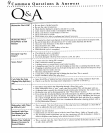
IU
Dishwasher Leaks? • Check that the dishwasher is level. (Refer to the Installation Instructions.)
, Suds can cause the dishwasher to overflow. Measure the detergent carefully and use only
detergents designed for use in a dishwasher. Less detergent is needed in soft water. Try anoth-
er brand if sudsing continues.
• Follow directions closely on how to add a forgotten item. (pg. 7)
,_ Be sure the rinse aid lid is securely attached and product is not leaking.
Food Soil Remains , Check water temperature. (pg. 5)
on Dishes? ¢ Run hot water at the sink before starting the dishwasher.
Select Super Scrub Plus.
• Check water hardness and adjust detergent amount accordingly. (pg. 5)
• Use fresh detergent stored in a cool dry place.
Select proper cycle for the soil level.
• Load items so they do not block the wash arms or center tower. (pgs. 2-4)
• Load the utensil basket with some handles up and some down to prevent nesting.
, Do not place glasses over tines.
• Prior to loading, scrape off burnt on foods and wipe the starchy film from utensils used with
pasta, rice and oatmeal. These soils require more energy than the rest of the load to clean.
• Select Extra Rinse.
Glasses are ® Always use a rinse aid.
Cloudy/Spotted? * Check water temperature, incoming water should be 120-140 ° F (49-60 ° C).
,_ Confirm that the cloudiness is removable by soaking the item in white vinegar for approxi-
mately 5 minutes. If removed, the problem is due to hard water. Adjust detergent amount
being used to match water hardness (pg. 5). Be sure detergent is fresh, stored properly and a
high quality brand.
,_ If cloudiness is not removable, it is etching. This is an erosion of the surface of the glassware
and can be caused by water that is too hot, from using too much detergent or by prewashing.
Detergent needs food soil to act upon. If etching has occurred, the glassware is permanently
damaged. To prevent further etching, adjust the detergent amount to match the water hardness,
stop prewashing, and be sure incoming water temperature is not greater than 140° F (60° C).
Aluminum utensils or pans can leave marks when they rub against other items. Leave a slight
Items Washed in the space between items.
Dishwasher or the _ iron in the water can leave a yellow, brown or orange film on dishes or the dishwasher tub. A filter
Dishwasher Tub may be needed. Check with a water treatment company,
Itself are , Color from tomato-based food soils can temporarily adhere to interior dishwasher components.
Stained/Discolored? This staining will gradually fade over time. Use a detergent containing chlorine bleach for better
stain fighting.
,_ Be sure Heated Dry is selected.
Water droplets may form on the inner door as part of the drying process.
Always use a rinse aid like Jet Dry* or Cascade Rinse Aid*. Turn adjustable rinse aid cap to
Items Not Properly the MAX setting.
Dried/Moisture is . Check water temperature. (pg. 5)
Present on the Select Sanitize,
Dishwasher _ Increase detergent amount to match water hardness. (pg. 5)
Interior After the , Load properly. (pgs. 2-4)
Dry Cycle? _ Plastic and teflon items are difficult to dry because the porous surface tends to collect water
droplets. Towel drying may be necessary.
¢, Glasses and cups with concave bottoms hold water and require towel drying.
Dishware is , Load dishes according to instructions so they do not strike each other. (pgs. 2-4)
Chipped? • Washing antique china/crystal in the dishwasher is not recommended.
• Do not load glasses over the tines.
¢ Do not overload.
* Brand names are trademarks of the respective manufacturer.














